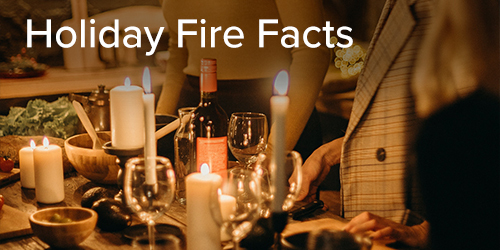Flickering lights, winter greenery and festive celebrations are hallmarks of the holiday season, but they also present fire risks that can quickly turn this festive time of year into a devastating one. We feel one of our jobs is to help educate the public about potential fire risks during the holidays so we’ve compiled some information from NFPA to help everyone enjoy the season safely.
Christmas tree fire facts:
- On average, one of every 52 reported home fires that began with a Christmas tree resulted in a death, compared to an average of one death per 135 total reported home fires.
- Two of every five (39%) home Christmas tree fires started in the living room.
- Between 2013-2017, U.S. fire departments responded to an average 160 home fires that started with Christmas trees per year. These fires caused an average of three deaths, 15 injuries, and $10 million in direct property damage annually.
- One-fifth (21%) of Christmas tree fires were intentional
- Electrical distribution or lighting equipment was involved in 44% of home Christmas tree fires.
- In one-quarter (25%) of the Christmas tree fires, some type of heat source, such as a candle or equipment, was too close to the tree.
- Roughly three-quarters of Christmas tree fires occurred in December or January.
Holiday decoration fire facts:
- One-fifth (20%) of the home decoration fires occurred in December.
- S. fire departments responded to an estimated average of 780 home structure fires per year that began with decorations, excluding Christmas trees, in 2013-2017. These fires caused an annual average of three civilian fire deaths, 34 civilian fire injuries and $12 million in direct property damage.
- The decoration was too close to a heat source such as a candle or equipment in more than two of every five (44%) fires.
- One-fifth (21%) of the decoration fires started in the kitchen. Sixteen percent started in the living room, family room or den.
- Nine percent of decoration fires were intentional.
Holiday cooking fire facts:
- Thanksgiving is the peak day for home cooking fires, followed by Christmas Day and Christmas Eve.
- Cooking equipment was involved in one of every five (19%) of home decoration fires. This can happen when a decoration is left on or too close to a stove or other cooking equipment.
Candle fire facts:
- The two peak days for candle fires were Christmas and Christmas Eve.
- Candle fires peak in December. January ranked second. Eighteen percent of December candle fires started in the living room and 8% started in the dining room compared to 14% and 3% for those areas during the rest of the year.
- On average, 22 home candle fires were reported each day between 2013-2017.
- Three of every five (60%) candle fires started when something that could burn, such as furniture, mattresses or bedding, curtains, or decorations, was too close to the candle.
Firework fire facts:
- Ten percent of fireworks fires occur during the period from December 30 through January 3, with the peak on New Year’s Day.
Jones Companies asks everyone to follow these tips to keep you and your family safe during this holiday season. We wish you a very Merry Christmas and a wonderful New Year.

